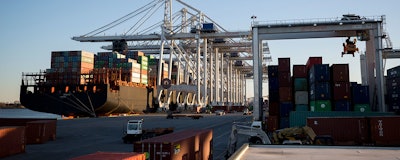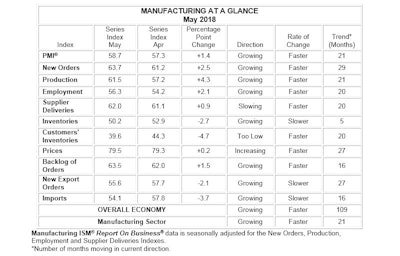
Economic activity in the manufacturing sector expanded in May, and the overall economy grew for the 109th consecutive month, say the nation’s supply executives in the latest Manufacturing ISM Report On Business.
Manufacturing expanded in May as the PMI registered 58.7 percent, an increase of 1.4 percentage points from the April reading of 57.3 percent. This indicates strong growth in manufacturing for the 21st consecutive month, led by continued expansion in new orders, production and employment. However, inventories are struggling to maintain expansion levels, and suppliers continue to deliver at essentially the same rate as the previous month, relative to production. A reading above 50 percent indicates that the manufacturing economy is generally expanding; below 50 percent indicates that it is generally contracting.

Timothy R. Fiore, CPSM, C.P.M., Chair of the Institute for Supply Management (ISM) Manufacturing Business Survey Committee states, “The past relationship between the PMI and the overall economy indicates that the PMI for May (58.7 percent) corresponds to a 4.8-percent increase in real gross domestic product (GDP) on an annualized basis.”
A PMI above 43.2 percent, over a period of time, generally indicates an expansion of the overall economy. Therefore, the May PMI indicates growth for the 109th consecutive month in the overall economy and the 21st straight month of growth in the manufacturing sector.
Comments from the panel reflect continued expanding business strength. Demand remains strong, with the New Orders Index at 60 or above for the 13th straight month, and the Customers’ Inventories Index remaining at very low levels. The Backlog of Orders Index continued expanding, with its highest reading since April 2004, when it registered 66.5 percent. Consumption, described as production and employment, continues to expand in spite of labor and skill shortages.
The Prices Index is at its highest level since April 2011, when it registered 82.6 percent. Demand remains robust, but the nation’s employment resources and supply chains continue to struggle. Respondents say price pressure at their companies is causing price-increase discussions.
Orders, Production and Inventory
The Inventories Index registered 50.2 percent in May, which is a decrease of 2.7 percentage points when compared to the 52.9 percent reported for April, indicating raw materials inventories grew in May.
“Suppliers were not able to maintain desired inventory expansion levels consistent with production demands for the third straight month. Wide-scale supplier lead-time extensions and freight uncertainties continue to impact inventory accounts,” says Fiore.
ISM’s New Orders Index registered 63.7 percent in May, which is an increase of 2.5 percentage points when compared to the 61.2 percent reported for April, indicating growth in new orders for the 29th consecutive month.
“The faster rate of new orders expansion reversed a two-month expansion slowing and supported the index being above 60 percent for the 13th straight month. Customer inventories remain too low, and backlog expansion continues at very high levels,” says Fiore.
ISM’s Production Index registered 61.5 percent in May, which is an increase of 4.3 percentage points when compared to the 57.2 percent reported for April, indicating growth in production for the 21st consecutive month.
“Production expansion continues; reversing four months of expansion slowing and contributing positively to PMI® expansion in May. Labor constraints and supply chain disruptions, however continue to limit full production potential,” says Fiore.
An index above 51.5 percent, over time, is generally consistent with an increase in the Federal Reserve Board’s Industrial Production figures.
ISM’s Backlog of Orders Index registered 63.5 percent in May, which is 1.5 percentage points higher than the 62 percent reported in April, indicating growth in order backlogs for the 16th consecutive month. Backlog expansion continued during the period, with the index reaching its highest level since April 2004, when it registered 66.5 percent. Strong backlog, extremely low levels of customer inventory and continued strong new order expansion indicate that production requirements should remain robust into Q3.
Exports, Imports and Prices
ISM’s New Export Orders Index registered 55.6 percent in May, a decrease of 2.1 percentage points when compared to the 57.7 percent reported for April, indicating growth in new export orders for the 27th consecutive month.
“Five of six big industry sectors continued to expand export activity during the period, in spite of comments noting the strength of the U.S. Dollar,” says Fiore.
ISM’s Imports Index registered 54.1 percent in May, a decrease of 3.7 percentage points when compared to the 57.8 percent reported for April, indicating that imports grew in May for the 16th consecutive month. Imports continued to expand to support production demand, but at slower expansion rates.
The ISM Prices Index registered 79.5 percent in May, an increase of 0.2 percentage point from the April level of 79.3 percent, indicating an increase in raw materials prices for the 27th consecutive month. In May, 62.2 percent of respondents reported paying higher prices, 3.1 percent reported paying lower prices, and 34.7 percent of supply executives reported paying the same prices as in April. The Prices Index again expanded to its highest level since May 2011, when it registered 82.6 percent.
“The increases in prices across all industry sectors continues. The Business Survey Committee noted price increases in metals (all steels, steel components, aluminum and copper), corrugate, freight, electronic components, wood and some chemicals. Shortages continue in electronics components, with steels, steel-based products, electrical components, aluminum and freight added to the list this month,” says Fiore.
A Prices Index above 52.4 percent, over time, is generally consistent with an increase in the Bureau of Labor Statistics (BLS) Producer Price Index for Intermediate Materials.
Employment
ISM’s Employment Index registered 56.3 percent in May, an increase of 2.1 percentage points when compared to the April reading of 54.2 percent. This indicates growth in employment in May for the 20th consecutive month.
“Employment reversed two months of slowing expansion and supported production growth. Respondents continue to see the labor market as a constraint to their production and their suppliers’ production,” says Fiore.
An Employment Index above 50.8 percent, over time, is generally consistent with an increase in the Bureau of Labor Statistics (BLS) data on manufacturing employment.
The monthly Manufacturing ISM Report on Business is based on the survey results of approximately 350 professionals across 18 different industry sectors. The report is released on the first business day of each month and features the PMI Index as its key measure. For more information on the Institute for Supply Management, visit www.ism.ws.


















